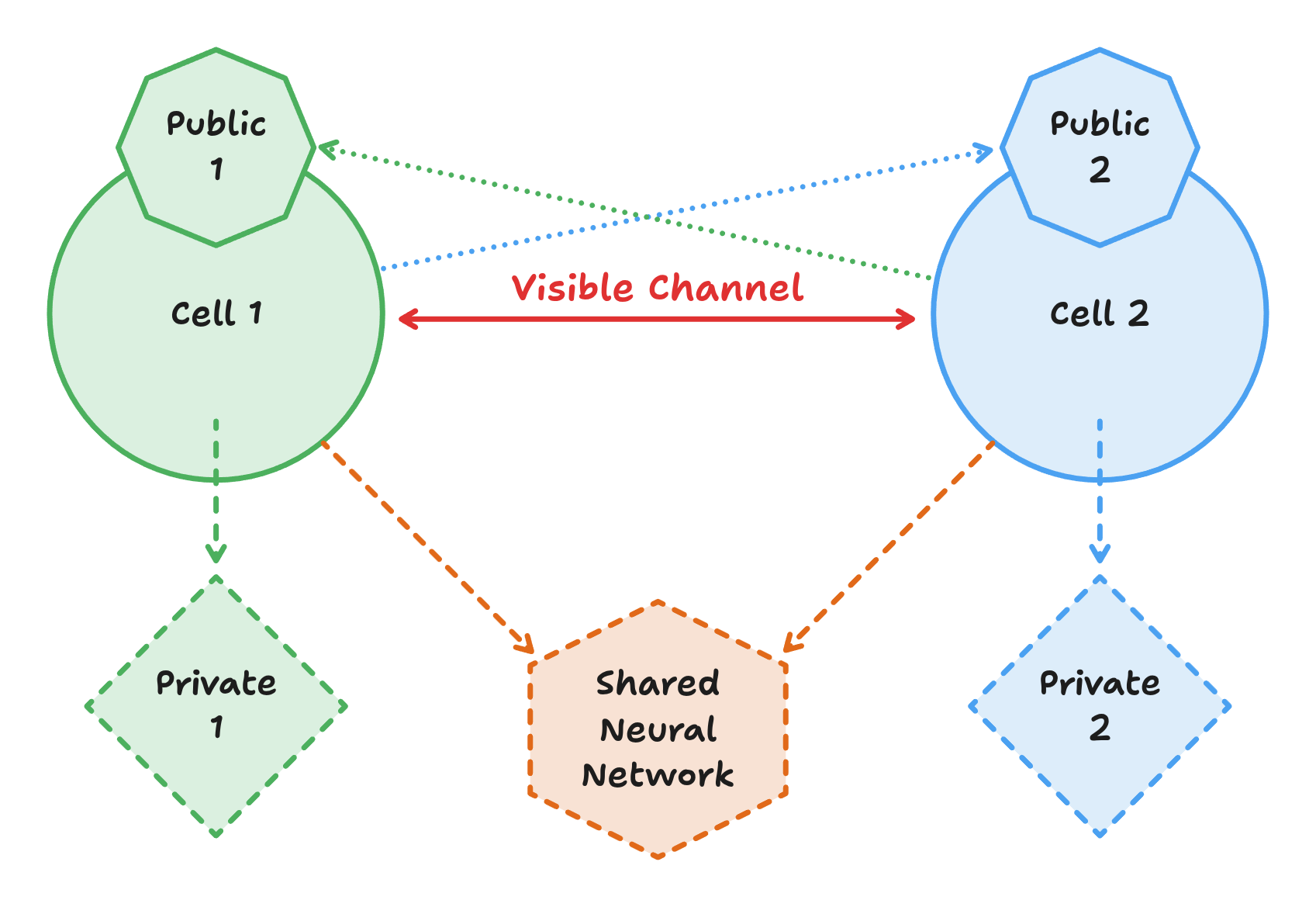Abstract
This study introduces EngramNCA, a neural cellular automaton (NCA) that integrates both publicly visible states and private, cell-internal memory channels, drawing inspiration from emerging biological evidence suggesting that memory storage extends beyond synaptic modifications to include intracellular mechanisms. The proposed model comprises two components: GeneCA, an NCA trained to develop distinct morphologies from seed cells containing immutable “gene” encodings, and GenePropCA, an auxiliary NCA that modulates the private “genetic” memory of cells without altering their visible states. This architecture enables the encoding and propagation of complex morphologies through the interaction of visible and private channels, facilitating the growth of diverse structures from a shared “genetic” substrate. EngramNCA supports the emergence of hierarchical and coexisting morphologies, offering insights into decentralized memory storage and transfer in artificial systems. These findings have potential implications for the development of adaptive, self-organizing systems and may contribute to the broader understanding of memory mechanisms in both biological and synthetic contexts.
Authors
Background
Abraham et al., 2019 challenged the common synapses dogma that states that information is merely stored in engrams. Emerging evidence shows that memory is also present privately within neural cells , and synapses are merely a visible reverberation of such private memories.
Proposition
This paper proposes an NCA model that allows for private memory storage within cells. They extend the classical NCA in two ways:
- Each cell has a publicly visible state that can be accessed by neighbouring cells and used as available information for computing cell state updates.
- Each cell has a private memory that is visible to only to the cell itself, representing some sort of internal state stored more permanently in a cell, that can possibly transmitted or made available to other cells.
All cellular automaton cells have their own internal neural network with identical weights for each cell. The network acts upon the visible channels in the cell’s neighbourhood, in addition to the cell’s own private memory. Since other cells don’t have access to other cell’s private memory, they need to learn to produce a reverberation of it through its visible channels to too coordinate with its neighbouring cells.

Training
First Training
Coordination is achieved by first training an NCA to grow from a seed cell to a set of primitive morphologies. The only cell initially containing the genetic information representing the target morphology is the seed cell itself. Each morphology is encoded by a different private representation. Therefore, this NCA has to learn to achieve the global task only through its visible channels. The neural network weights of this first NCA are then frozen and do not change. We name this first neural network GeneCA.
Second Training
Subsequently, another NCA is trained in addition to the previous, which does not manipulate and change the visible information of cells, but can only change their private genetic memory, i.e., a set of private channels. As such, it has to learn a mechanism to regulate the private information such that the previously learned primitive morphologies (or their combination) can be utilised and activated at the right time and in the right place. We name this second neural network GenePropCA, short for GenePropagationCA.
The GenePropCA mechanism is an abstraction for RNA molecular transmission between cells, which provides a form of functionality transfer. The transmitted functionality is stored in the cell’s internal memory and, in turn, affects the behaviour of the GeneCA (the cell’s visible state).
Models
GeneCA
The first model, which they call GeneCA, is tasked with learning the primitive embedding.
GenePropCA
The second model, which they call GenePropCA, is tasked with exploiting the gene embedding layer learned by the GeneCA.
Morphology
A morphology is simply the global shape or pattern that the cellular automaton produces when it evolves from its seed configuration.
Biologically, morphology means an organism’s form and structure; here it refers to the image (e.g. polygon, a lizard silhouette, or a moving glider)
Primitive
A primitive is one of the basic target shapes used to train the GeneCA. Examples include simple coloured polygons, body-part segments of a lizard, or straight lines. Each primitive has its own fixed binary encoding (“gene”) in the seed cell’s private channels, and GeneCA learns to grow exactly that primitive from the seed without any gene propagation.
Channel
Each CA cell’s state is a vector split into multiple channels:
- Visible channels: e.g. RGBA + public hidden channels that neighbouring cells can read, analogous to synaptic signals
- Private (gene) channels that only the cell itself can read or write, analogous to intracellular memory (e.g. RNA levels)
These channels together form the complete cell state, and both GeneCA and GenePropCA selectively update either the visible or the private channels at each step.